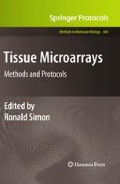Abstract
New high-throughput screening technologies have led to the identification of hundreds of genes with a potential role in cancer or other diseases. One way to prioritize the leads obtained in such studies is to analyze a large number of tissues for candidate gene expression. The TMA methodology is now an established and frequently used tool for high-throughput tissue analysis. The recipient block technology is the “classical” method of TMA making. In this method, minute cylindrical tissue punches typically measuring 0.6 mm in diameter are removed from donor tissue blocks and are transferred into empty “recipient” paraffin blocks. Up to 1,000 different tissues can be analyzed in one TMA block. The equipment is affordable and easy to use in places where basic skills in histology are available.
Access this chapter
Tax calculation will be finalised at checkout
Purchases are for personal use only
References
Kononen J, Bubendorf L, Kallioniemi A, Barlund M, Schraml P, Leighton S, Torhorst J, Mihatsch MJ, Sauter G, Kallioniemi OP. (1998) Tissue microarrays for high-throughput molecular profiling of tumor specimens. Nat Med 4:844–7.
Battifora H. (1986) The multitumor (sausage) tissue block: novel method for immunohistochemical antibody testing. Lab Invest 55:244–8.
Ruiz C, Seibt S, Al Kuraya K, Siraj AK, Mirlacher M, Schraml P, Maurer R, Spichtin H, Torhorst J, Popovska S, Simon R, Sauter G. (2006) Tissue microarrays for comparing molecular features with proliferation activity in breast cancer. Int J Cancer 118:2190–4.
Simon R, Nocito A, Hübscher T, Bucher C, Torhorst J, Schraml P, Bubendorf L, Mihatsch MJ, Moch H, Wilber K, Schötzau A, Kononen J, Sauter G. (2001) Patterns of her-2/neu amplification and overexpression in primary and metastatic breast cancer. J Natl Cancer Inst 93:1141–6.
Torhorst J, Bucher C, Kononen J, Haas P, Zuber M, Kochli OR, Mross F, Dieterich H, Moch H, Mihatsch M, Kallioniemi OP, Sauter G. (2001) Tissue microarrays for rapid linking of molecular changes to clinical endpoints. Am J Pathol 159:2249–56.
Schlomm T, Iwers L, Kirstein P, Jessen B, Kollermann J, Minner S, Passow-Drolet A, Mirlacher M, Milde-Langosch K, Graefen M, Haese A, Steuber T, Simon R, Huland H, Sauter G, Erbersdobler A. (2008) Clinical significance of p53 alterations in surgically treated prostate cancers. Mod Pathol 21:1371–8.
Bubendorf L, Kolmer M, Kononen J, Koivisto P, Mousses S, Chen Y, Mahlamaki E, Schraml P, Moch H, Willi N, Elkahloun AG, Pretlow TG, Gasser TC, Mihatsch MJ, Sauter G, Kallioniemi OP. (1999) Hormone therapy failure in human prostate cancer: analysis by complementary DNA and tissue microarrays. J Natl Cancer Inst 91:1758–64.
Nocito A, Bubendorf L, Tinner EM, Suess K, Wagner U, Forster T, Kononen J, Fijan A, Bruderer J, Schmid U, Ackermann D, Maurer R, Alund G, Knonagel H, Rist M, Anabitarte M, Hering F, Hardmeier T, Schoenenberger AJ, Flury R, Jager P, Fehr JL, Schraml P, Moch H, Mihatsch MJ, Gasser T, Sauter G. (2001) Microarrays of bladder cancer tissue are highly representative of proliferation index and histological grade. J Pathol 194:349–57.
Author information
Authors and Affiliations
Corresponding author
Editor information
Editors and Affiliations
Rights and permissions
Copyright information
© 2010 Springer Science+Business Media, LLC
About this protocol
Cite this protocol
Mirlacher, M., Simon, R. (2010). Recipient Block TMA Technique. In: Simon, R. (eds) Tissue Microarrays. Methods in Molecular Biology, vol 664. Humana Press, Totowa, NJ. https://doi.org/10.1007/978-1-60761-806-5_4
Download citation
DOI: https://doi.org/10.1007/978-1-60761-806-5_4
Published:
Publisher Name: Humana Press, Totowa, NJ
Print ISBN: 978-1-60761-805-8
Online ISBN: 978-1-60761-806-5
eBook Packages: Springer Protocols

